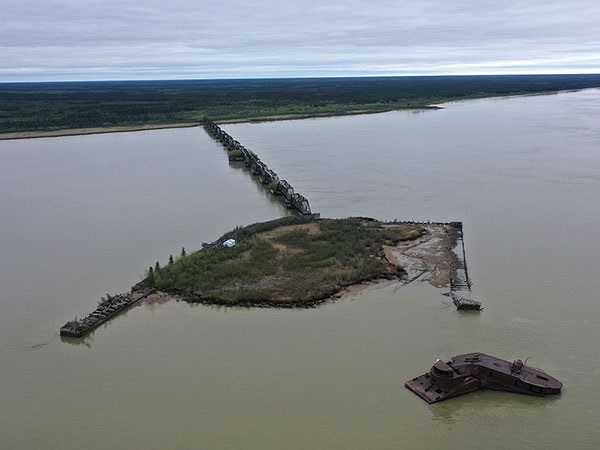Alberta
MB/SK/AB NeeStaNan Utilities Corridor: First Nations-led utility corridor is a 21st-century nation-building initiative

Port Nelson is 300 kilometres south of Churchill and has a longer ice-free season. In fact, a concrete jetty constructed (and never used) at Port Nelson nearly a hundred years ago remains in place.
From the Frontier Centre for Public Policy
By Terry Etam
“The trading of goods has been in our DNA as Indigenous People for centuries, but somewhere along the way this was lost. It’s time to regain our prosperity, for the betterment of our communities and for our country.” – NeeStaNan website
Ever feel like you’re being neglected by either governments or the various power centers that dominate life? The big places get all the attention, have all the votes, have all the buzz. In Canada, fewer than ten such centers dominate the country. If you’re not in one of those, you won’t know much political power, there won’t be much clout, there won’t be much of anything.
And if you want to know how far you can get from a circle of influence, consider Census Division No. 23, a great big administrative district in northern Manitoba. The size and ruggedness are mindboggling; No. 23 encompasses an area of 233,578 square km/90,185 square miles, six times the area of Switzerland, yet the region’s total population is 4,690. The population density, rounded to the nearest person-per-square km, is zero. If you round it to the nearest tenth of a square km, it is still zero.
It is extremely hard for people of regions like this to register on the national radar for any number of reasons, some of which are just logistical (remote location) and some of which are just rude realities (not much political capital up for grabs in No. 23).29dk2902l
The people of regions like this tend to be absent from all sorts of things, including resource development, even if it happens in these regions. Yes, there will be some local employment, and positive economic spinoffs, but nothing in the way of meaningful ownership or control.
But that may be about to change, for a significant swath of Manitoba, Saskatchewan, and the northeastern part of Alberta. Underway is the NeeStaNan utility corridor, stretching from northern Alberta through north-central Saskatchewan and on to the shores of Hudson Bay in Manitoba.
The significance of this corridor could be profound. It will provide tidewater access for landlocked western Canadian resources that otherwise need to travel to the west coast, or other less efficient routes. As one of the best examples, Saskatchewan must move potash to market via Vancouver, meaning a trip through the Rocky Mountains and on to the coast.
By utilizing the NeeStaNan utility corridor, potash will be able to move to large markets like Brazil far more efficiently. The distance to seawater via Hudson Bay is 630 km/390 miles less than by going through BC ports, and here’s the real economic kicker: the sea route to Brazil’s market is actually 3,800 km less than current routes. That’s almost 2,400 miles, for American friends and for old times’ sake.
The corridor is planned to enter Hudson Bay not at Churchill, but at a much more direct and accessible point called Port Nelson. Port Nelson is some 300 kilometres/180 miles south of Churchill (Hudson Bay is really freaking big) and has a longer ice-free season. In fact, a concrete jetty constructed (and never used) at Port Nelson nearly a hundred years ago remains in place. Port Nelson isn’t a new idea.
The utility corridor isn’t simply a project to enhance the wellbeing of the FN bands along the way, although it will most certainly do that. It is also far more grand in scope: the utility corridor will help Canada’s heartland deliver industrial products to global markets in a more efficient way, and provide the sort of efficiencies that can help multiple Canadian industries enhance global competitiveness, all the while providing an economic boost that is infinitely better than what locals and First Nations along the way have ever known.
Many industries could benefit, including the oil and gas sector, and I’m going to say that now before any legislation passes that makes it illegal. There is potential to utilize the corridor to move rail cargoes, pipelines, lumber, agricultural products, raw materials, manufactured goods… an endless array of the stuff that makes Canada wealthy.
The project is enormously captivating right from its very name. “NeeStaNan” translates as “all of us”. How cool is that; inclusiveness not under the guise some overwrought mandate, but in the sense that the project is being structured to benefit a great number of parties. The home page of the NeeStaNan website describes the project as a utility corridor “uniting Canadians”. Now, doesn’t that phrase sound far more powerful coming from the heartland, from people with skin in the game, as opposed to insincere platitudes thrown about like confetti on the campaign trail?
The utility corridor really could unite Canadians; it is a slingshot of vitality into Canada’s industrial base. It could benefit many critical industries, and open up new trade possibilities. It is a project designed to bring in many First Nations along the route that have very little to show for Canada’s development. It’s not a handout, it’s the opposite – a benefit to Canada and a great many Canadians.
Isn’t this what First Nations Self Determination should be about? Isn’t this a perfect dovetail with the interests of the people who live in these remote areas, who are the only ones there, and who deserve a say in how it is developed? Isn’t it amazing that it is a collaborative effort that by design will benefit industries that these First Nations have no direct stake in?
Isn’t it the best possible goal and achievement of all the efforts to bring First Nations fully into the Canadian matrix on a way that works for everyone, and that benefits everyone?
And who would be better than First Nations along the corridor’s path as the stewards of the corridor itself? Who knows the terrain better? I’ve been there, I grew up not in the path of the corridor but I could see it from a north facing window, and I’ll tell you it’s not territory for the faint of heart. Winters are brutal and long, summers are hot and buggy, and nature is relentless. Local expertise and wisdom would be invaluable.
I can’t really think of an infrastructure project of the past fifty years that could have such multi-dimensional benefits to so many Canadians. It is uplifting to see collaboration across many First Nations and the governments of three provinces. Ottawa may not like it, because the corridor is sure to empower an area of the country that has few votes to harvest, but that is all the more reason to get behind and support the project’s owners, organizers, and operators.
The NeeStaNan utility corridor might do more for a forgotten region of Canada, and its First Nations, than 150 years of federal government “help”. Let’s hope all three prairie provinces and the First Nations along the way bring the corridor into life and to its full potential.
Terry Etam is a columnist with the BOE Report, a leading energy industry newsletter based in Calgary. He is the author of The End of Fossil Fuel Insanity. You can watch his Policy on the Frontier session from May 5, 2022 here.
Alberta
Red Deer Justice Centre Grand Opening: Building access to justice for Albertans

The new Red Deer Justice Centre will help Albertans resolve their legal matters faster.
Albertans deserve to have access to a fair, accessible and transparent justice system. Modernizing Alberta’s courthouse infrastructure will help make sure Alberta’s justice system runs efficiently and meets the needs of the province’s growing population.
Alberta’s government has invested $191 million to build the new Red Deer Justice Centre, increasing the number of courtrooms from eight to 12, allowing more cases to be heard at one time.
“Modern, accessible courthouses and streamlined services not only strengthen our justice
system – they build safer, stronger communities across the province. Investing in the new Red Deer Justice Centre is vital to helping our justice system operate more efficiently, and will give people in Red Deer and across central Alberta better access to justice.”

Government of Alberta and Judiciary representatives with special guests at the Red Deer Justice Centre plaque unveiling event April 22, 2025.
On March 3, all court services in Red Deer began operating out of the new justice centre. The new justice centre has 12 courtrooms fully built and equipped with video-conference equipment to allow witnesses to attend remotely if they cannot travel, and vulnerable witnesses to testify from outside the courtroom.
The new justice centre also has spaces for people taking alternative approaches to the traditional courtroom trial process, with the three new suites for judicial dispute resolution services, a specific suite for other dispute resolution services, such as family mediation and civil mediation, and a new Indigenous courtroom with dedicated venting for smudging purposes.
“We are very excited about this new courthouse for central Alberta. Investing in the places where people seek justice shows respect for the rights of all Albertans. The Red Deer Justice Centre fills a significant infrastructure need for this rapidly growing part of the province. It is also an important symbol of the rule of law, meaning that none of us are above the law, and there is an independent judiciary to decide disputes. This is essential for a healthy functioning democracy.”
“Public safety and access to justice go hand in hand. With this investment in the new Red Deer Justice Centre, Alberta’s government is ensuring that communities are safer, legal matters are resolved more efficiently and all Albertans get the support they need.”
“This state-of-the-art facility will serve the people of Red Deer and surrounding communities for generations. Our team at Infrastructure is incredibly proud of the work done to plan, design and build this project. I want to thank everyone, at all levels, who helped make this project a reality.”
Budget 2025 is meeting the challenge faced by Alberta with continued investments in education and health, lower taxes for families and a focus on the economy.

Quick facts
- The new Red Deer Justice Centre is 312,000 sq ft (29,000 m2). (The old courthouse is 98,780 sq ft (9,177 m2)).
- The approved project funding for the Red Deer Justice Centre is about $191 million.
Alberta
CPP another example of Albertans’ outsized contribution to Canada

From the Fraser Institute
By Tegan Hill
Amid the economic uncertainty fuelled by Trump’s trade war, its perhaps more important than ever to understand Alberta’s crucial role in the federation and its outsized contribution to programs such as the Canada Pension Plan (CPP).
From 1981 to 2022, Albertan’s net contribution to the CPP—meaning the amount Albertans paid into the program over and above what retirees in Alberta received in CPP payments—was $53.6 billion. In 2022 (the latest year of available data), Albertans’ net contribution to the CPP was $3.0 billion.
During that same period (1981 to 2022), British Columbia was the only other province where residents paid more into the CPP than retirees received in benefits—and Alberta’s contribution was six times greater than B.C.’s contribution. Put differently, residents in seven out of the nine provinces that participate in the CPP (Quebec has its own plan) receive more back in benefits than they contribute to the program.
Albertans pay an outsized contribution to federal and national programs, including the CPP because of the province’s relatively high rates of employment, higher average incomes and younger population (i.e. more workers pay into the CPP and less retirees take from it).
Put simply, Albertan workers have been helping fund the retirement of Canadians from coast to coast for decades, and without Alberta, the CPP would look much different.
How different?
If Alberta withdrew from the CPP and established its own standalone provincial pension plan, Alberta workers would receive the same retirement benefits but at a lower cost (i.e. lower CPP contribution rate deducted from our paycheques) than other Canadians, while the contribution rate—essentially the CPP tax rate—to fund the program would likely need to increase for the rest of the country to maintain the same benefits.
And given current demographic projections, immigration patterns and Alberta’s long history of leading the provinces in economic growth, Albertan workers will likely continue to pay more into the CPP than Albertan retirees get back from it.
Therefore, considering Alberta’s crucial role in national programs, the next federal government—whoever that may be—should undo and prevent policies that negatively impact the province and Albertans ability to contribute to Canada. Think of Bill C-69 (which imposes complex, uncertain and onerous review requirements on major energy projects), Bill C-48 (which bans large oil tankers off B.C.’s northern coast and limits access to Asian markets), an arbitrary cap on oil and gas emissions, numerous other “net-zero” targets, and so on.
Canada faces serious economic challenges, including a trade war with the United States. In times like this, it’s important to remember Alberta’s crucial role in the federation and the outsized contributions of Alberta workers to the wellbeing of Canadians across the country.
-

 2025 Federal Election1 day ago
2025 Federal Election1 day agoStudy links B.C.’s drug policies to more overdoses, but researchers urge caution
-

 2025 Federal Election2 days ago
2025 Federal Election2 days agoConservatives promise to ban firing of Canadian federal workers based on COVID jab status
-

 Business1 day ago
Business1 day agoIs Government Inflation Reporting Accurate?
-

 International2 days ago
International2 days agoPope Francis Got Canadian History Wrong
-

 2025 Federal Election2 days ago
2025 Federal Election2 days agoCarney’s Hidden Climate Finance Agenda
-

 2025 Federal Election2 days ago
2025 Federal Election2 days agoWhen it comes to pipelines, Carney’s words flow both ways
-

 Environment2 days ago
Environment2 days agoExperiments to dim sunlight will soon be approved by UK government: report
-

 Censorship Industrial Complex2 days ago
Censorship Industrial Complex2 days agoIs free speech over in the UK? Government censorship reaches frightening new levels





